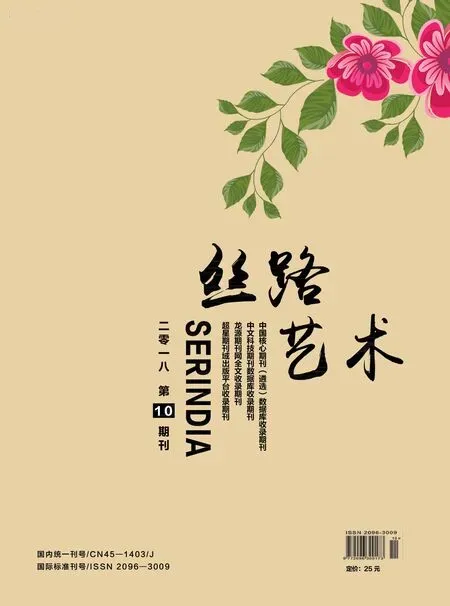A STUDY OF THE LITERARY CREATION OF THE TALE OF THE INCOMPARABLE PRINCE
杨本加(西南民族大学,四川 成都 610041)
Abstract:Between the 12th century and the 18th century, many powerful and abundant literary works were composed; a lot of great writers appeared at that time.Because many Tibetan scholars went to India and learned about Indian literature and its religion, their writing style and aesthetic were based on the cannon of genre from India and developed in depth.The Tale of the Incomparable Prince is an illustration of that writing style.His writing style is inf l uenced by Indian literature and took essences in many ways.So this thesis paper analyses his literary creation of The Tale of the Incomparable Prince.Through the research, this paper will introduce and analyze the origin of author’s literary creation and its achievements, which beginning of Tibetan humanitarian fiction writing style, and to express the aspirations of secular’s life view and psychological yearning by creating the prefect image of the characters.
Key words:Aesthetic;Tibetan tale;aphorisms; avadana;humanitarianism
1.INTRODUCTION
The word used for “tale” in Tibetan is not originally Tibetan, it comes from another language.However, that literary genre appeared hundreds of years ago.The Tibetan folktale’s history is long, rich and varied and folktales are an essential part of Tibetan literature.Folktales carry the wealth of knowledge created through the wisdom of the Tibetan people since the beginning of this culture.
In addition, folktales are a forum for society to fight for free marriage and describe the historical context, experiences and social life of Tibetans at different historical stages.Additionally, the ancient literature symbolizes the views or ideas of our ancestors.They used to be afraid of nature, and followed the Bon religion.So the religion controlled their beliefs.As in many cultures, stories began as declamatory literature[1], such as mythology, legends and tales.All of those types of literature fi rst appeared in oral language and were used to express life and social consciousness in the past.
2.1 The influence of the biography of the Buddha on the literary styles
The biography of the Buddha was written in Tibetan language after the rule of King Sron btsan, because he ruled using the ten virtues for populace to let them learn about the biography of Buddha.The ten virtues were useful for reaching consensus in politics and religion through studying Buddhism.So Buddhism generally inf l uenced Tibetan traditional culture and religion.As a result, writers started producing biographies of the Buddha in avadana stories, poems, and aphorisms[2]in Tibetan.
In ancient times, most scholars were religious men or monks and they used the Buddhist worldview or religious themes to write literary works in order to educate people.Therefore, most literary works and fi ction were inf l uenced by Buddhism or the biographies of Buddha.The biographies of Buddha used rich character descriptions and descriptive settings to attract readers to internalize religions views.
We can see that Tibetan literature follows the patterns of Indian stories, biographies and avadana.The writing styles also ref l ect Indian styles.The descriptions of environment, character development, plots of novels and psychologies are similar to Indian fiction, so it can be said that Indian culture served as the foundation of Tibetan culture, and generally became more varied and specif i c.
2.2 The Buddhist worldview or religious themes from The Tale of the Incomparable Prince
The Tale of the Incomparable Prince is a call for remembrance of Tibetan history during the time of the fifth Dalai Lama and Dga ldan Palace[3](1648-1952).The monastery was the central place to hold,preserve and spread the cultures, and administrative personnel were educated there.The lay people followed a spiritual teacher from the monastery to study the culture and religion, because there were not any schools like today.Because of the religious aspects of education, most lay people were influenced by the Buddhist worldview and monastic education.
Thus, most literary works written at the time expressed religious views, such as virtue and negativity, the four noble truths, reincarnation,samsara, nirvana and dharma.Effectively, they illustrated the views of dharma, which explains that one’s present physical and mental circumstances are the culmination of one’s prior virtuous or non virtuous actions.
The Tale of the Incomparable Prince is told within the matrix of these ideas.The prince turned his mind toward the dharma, he realized the sufferings from samsara, he noticed the pains from love, war and secularism.In the novel, we can see samsara is synonymous with misery.Suffering is the obvious physical and psychological wretchedness associated with each realm of existence.Birth, sickness, aging, dying and not getting or losing one’s desires are all unpleasant physical or mental states, and the key to release all of those pains is learning the four noble truths.
[1]Declamatory literature:It's the main way of spreading of folk literature, people's oral creation.In Tibetan it’s called().This literature including prose myths, folk tales,folk stories, rhymes, songs and operas, rap literature, proverbs riddles and genres of folk works.
[2]Aphorisms:An aphorism is a tersely phrased statement of a truth or opinion, or a brief statement of a principle.A short pithy instructive saying.()
[3]Dga ldan Palace: Government house in Lhasa, it had started during the great fifth Dalai Lama.It is the official emblem of the central Tibetan administration government in exile headquartered in past().(1648-1952)
3.REFERENCES
[1].Mdo mkhar zhab sdrung tshe ring dbang rgyal.2008.The Tale of the Incomparable Prince,,拉萨市林廓北路20号: 西藏人民出版社
[2].Mdo mkhar zhabs drung tshe ring dbang rgyal2002.Mi dbang rtogs brjod,西藏人民出版社
[3].Zhou zha ལ་མོ་འབྲུག་པ།.2004北京市和平里北街14号: 北京民族出版社
[4].Huo kang suo lang bian ba1999中国藏学出版社
[5].Beth Newman.1996.The Tale of the Incomparable Prince,translated with an introduction by Beth Newman , Harper Collines Publishers

